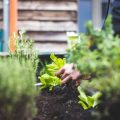Introduction: The Hidden Impact of Our Gardens
When we step out into our gardens, watering cans in hand and trowels at the ready, it’s easy to see these green spaces as pure pockets of nature. Yet, beneath the surface of every flourishing border or thriving allotment plot lies a hidden story—a tale of carbon footprints shaped by our everyday choices. From the compost we spread to the plastic pots we stack in sheds, each decision contributes quietly but surely to our environmental impact. British gardening has long been steeped in tradition, with generations gathering at community gardens and neighbours swapping advice over hedges. But as we potter about, sowing seeds and nurturing seedlings, it’s worth pausing to consider how modern materials—especially those like peat-based composts and single-use plastics—are shaping not just our beds and borders, but also the planet’s future. In this series, we’ll dig deep into the most common high-carbon garden materials used across the UK, exploring their effects and planting seeds for more sustainable choices along the way.
2. Peat-Based Compost: A British Staple Under Scrutiny
For generations, peat-based compost has been as much a part of British gardening culture as wellies and allotment sheds. It’s the soft, dark material gardeners have lovingly spread over their plots to nurture everything from prize-winning marrows to spring daffodils. But beneath its earthy aroma lies a hidden cost that’s sparking conversations at garden gates across the UK. Let’s explore why peat has held such a cherished place in British gardens and why it’s now coming under environmental scrutiny.
The Traditional Role of Peat in British Allotments
Allotments are woven into the fabric of UK communities—patches of green where families bond over planting, weeding, and harvesting. Historically, peat compost was prized for its ability to retain moisture and provide a gentle home for young roots, making it an almost automatic choice for generations of gardeners. Ask any seasoned allotmenteer and they’ll likely recall their first encounter with peat: rich, spongy, and seemingly magical in helping seedlings thrive.
Environmental Consequences: The High Carbon Cost
Yet, this gardening tradition comes with a heavy environmental price tag. Peatlands are unique habitats, teeming with wildlife and serving as vital carbon sinks. When peat is harvested for compost, centuries-old ecosystems are disrupted, releasing stored carbon dioxide back into the atmosphere. This process not only contributes to climate change but also threatens rare plant and animal species native to these wetlands.
| Aspect | Peat-Based Compost | Peat-Free Alternatives |
|---|---|---|
| Carbon Footprint | High (peat extraction releases CO₂) | Lower (utilises renewable materials) |
| Biodiversity Impact | Destructive to peatland habitats | Supports habitat conservation |
| Water Retention | Excellent | Varies by blend, improving yearly |
| Cultural Tradition | Deeply rooted in UK gardening | Growing acceptance among new generations |
The Shift Towards Peat-Free Alternatives
The growing awareness of peat’s environmental impact has spurred innovation among British gardeners and suppliers alike. Modern peat-free composts use materials like coir (coconut husk), wood fibre, or green waste, offering earth-friendly options without sacrificing performance. While some old hands may be reluctant to switch, many families find joy in experimenting together—testing new blends and watching their plants flourish just as heartily.
A Family Challenge: Growing Greener Together
If you’re tending your own plot—be it grand or pocket-sized—why not turn the shift away from peat into a family project? Discuss the journey of your compost, compare plant growth between different mixes, and celebrate small successes. In this way, every handful of peat-free compost becomes not just a lesson in sustainability but a shared story about nurturing both plants and planet.

3. Plastic in the Patch: Pots, Tools, and Tunnels
Step into any British garden centre or allotment, and you’ll spot plastic everywhere—from sturdy pots stacked by the tills to polytunnels arching over thriving veg patches. Over the past few decades, these everyday items have woven themselves into the fabric of our gardening routines. Their appeal is easy to see: plastic seed trays make starting off sweet peas or sunflowers a doddle, lightweight watering cans are perfect for little hands keen to help out, and plastic grow bags mean even city dwellers can nurture tomatoes on a tiny patio.
Yet, while plastic’s convenience is undeniable, it comes with a heavier environmental cost than many gardeners realise. Unlike peat—which at least hails from organic origins—plastic is made from fossil fuels and lingers in landfill for centuries if not recycled. Many of us fondly reuse old plant pots or pass them on to neighbours at local plant swaps, but brittle trays and torn compost sacks too often end up tossed away after just one season. Even durable polytunnels, which shelter tender beans and courgettes from unpredictable British weather, eventually degrade under UV rays, shedding microplastics into the soil beneath.
The longevity of plastic can be a double-edged trowel: yes, it lasts through seasons of wind and rain, but this resilience means its footprint stretches far beyond our own gardening years. As parents and carers nurturing young green thumbs, we’re faced with choices every spring—do we reach for the handy plastic pot or seek alternatives like biodegradable fibre trays or sturdy terracotta? The plants may not mind what they grow in, but the planet certainly takes notice. By reflecting on how plastics have become so deeply rooted in our gardens, we can begin to reimagine a patch that’s kinder to both seedlings and soil alike.
4. Imported Hardscape: Stones, Decking, and Artificial Grass
When we wander through our neighbourhoods or browse garden inspiration on British TV, its hard not to notice the rise of sleek stone patios, composite decking, and lush green lawns that stay perfectly trimmed all year round. Many of these garden materials, however, come with a hidden carbon price tag—especially when they are sourced from distant corners of the globe. Lets have a closer look at how imported hardscape features add to our gardens’ carbon footprints and why their popularity continues to grow across the UK.
The Allure of Imported Stones and Decking
Natural stones like Indian sandstone and granite have become highly sought after for British gardens due to their durability and aesthetic appeal. Similarly, hardwood decking—often sourced from tropical forests—offers a warm and polished finish that’s hard to resist. While these materials can transform a dull patch of grass into an elegant outdoor living space, their environmental impact is significant. The process of quarrying, transporting (sometimes over thousands of miles by sea and lorry), and installing these materials contributes substantially to greenhouse gas emissions.
Artificial Grass: Convenience vs. Carbon Cost
Artificial grass has boomed in popularity for families seeking low-maintenance lawns that stay green without mowing or watering. However, the manufacturing process involves plastics derived from fossil fuels, and the product is often shipped from overseas factories. While it saves time and water, its production and disposal present sustainability challenges that are important to consider.
Comparing the Carbon Footprint of Popular Garden Hardscapes
| Material | Common Source | Main Appeal | Estimated Carbon Footprint* |
|---|---|---|---|
| Indian Sandstone | India | Durable, attractive colour range | High (quarrying + long-distance transport) |
| Tropical Hardwood Decking | Southeast Asia, South America | Sleek appearance, longevity | Very High (deforestation + shipping) |
| Artificial Grass | Europe/Asia factories | No-mow convenience, evergreen look | High (plastic production + transport) |
| UK-sourced Stone or Timber | United Kingdom | Local character, lower travel distance | Lower (reduced transport emissions) |
*Estimates based on cradle-to-garden analysis; actual impact varies by supplier and installation method.
The Trend’s Roots: Why Are Imports So Popular?
The drive towards imported landscaping materials can be linked to both fashion and function. Many homeowners are inspired by global design trends seen online or in lifestyle magazines. Additionally, unpredictable British weather encourages solutions like artificial grass that offer year-round usability—especially appealing for families with young children or pets. However, as awareness grows about climate change, more gardeners are beginning to weigh these conveniences against their environmental cost.
5. Fertilisers & Chemicals: Quick Fix or Slow Burn?
If you stroll through any British suburb, you’ll spot lawns so lush and borders so vibrant they almost look painted on. But what’s the secret behind these envy-inducing gardens? For many, it’s the use of synthetic fertilisers and chemical pesticides—a quick fix that promises perfection. However, beneath that flawless green lies a story of carbon emissions with long-lasting effects.
Synthetic fertilisers, packed with nitrogen, phosphorus, and potassium, are manufactured through energy-intensive processes. The classic example is the Haber-Bosch process for ammonia production—releasing vast amounts of greenhouse gases into our atmosphere. Every sprinkle on your flowerbed or allotment plot comes with an invisible carbon footprint that lingers far longer than the spring blooms.
Chemical pesticides, too, are widely used to keep roses free from aphids and cabbages safe from caterpillars. Yet, their production and transport add further emissions, not to mention the impact on soil health and biodiversity. When these substances enter our soils and waterways, they don’t just tackle pests—they disrupt the delicate balance that healthy gardens rely upon.
It’s easy to see why these products are so popular: British weather can be unpredictable, and who doesn’t want a garden that looks like something out of Chelsea Flower Show? But as we chase this ideal, we often overlook nature’s slower rhythms and quieter solutions—like composting, mulching with local materials, or encouraging beneficial insects.
As parents and gardeners alike, perhaps there’s a lesson here for our little ones: some fixes offer instant results but hidden costs. By swapping out quick chemical fixes for more thoughtful, earth-friendly practices, we can nurture not just our own patch of green—but also a future where our children can enjoy wild bees buzzing and worms wriggling underfoot.
6. Turning Over a New Leaf: Greener Garden Alternatives
As we wrap up our journey from peat to plastic, it’s time to sow seeds of change with greener choices. The heart of British gardening beats strongest when we nurture both our loved ones and the land beneath our feet. By embracing local, sustainable materials and rekindling traditional gardening wisdom, families can cultivate not just beautiful gardens, but thriving communities and a healthier planet.
Rediscovering Local Resources
Swap out imported, high-carbon products for home-grown solutions. British-made composts, wood chippings from local arborists, and recycled garden tools are all kinder to the earth. Choosing native plants reduces maintenance and water needs while supporting wildlife right outside your back door.
The Wisdom of Traditional Methods
Look to the past for inspiration—our grandparents often used what was at hand: leaf mould, homemade compost, or even simple straw mulch. These low-impact practices enrich soil naturally and invite children to join in, turning gardening into a family adventure rooted in heritage.
Cultivating Community Spirit
Allotments, community gardens, and plant swaps connect neighbours while reducing everyone’s environmental footprint. Sharing cuttings or surplus harvests fosters friendships and passes on green values from generation to generation.
Small Steps, Lasting Change
Every mindful choice—from using rainwater butts to avoiding single-use plastics—adds up over time. As parents and caretakers of our little ones and our planet, let’s encourage curiosity about nature and empower each other to try new, eco-friendly approaches.
Together, by turning over this new leaf, we can grow gardens that are as kind to the climate as they are joyful for families—proving that the most rewarding harvest is one shared with both people and the planet in mind.


